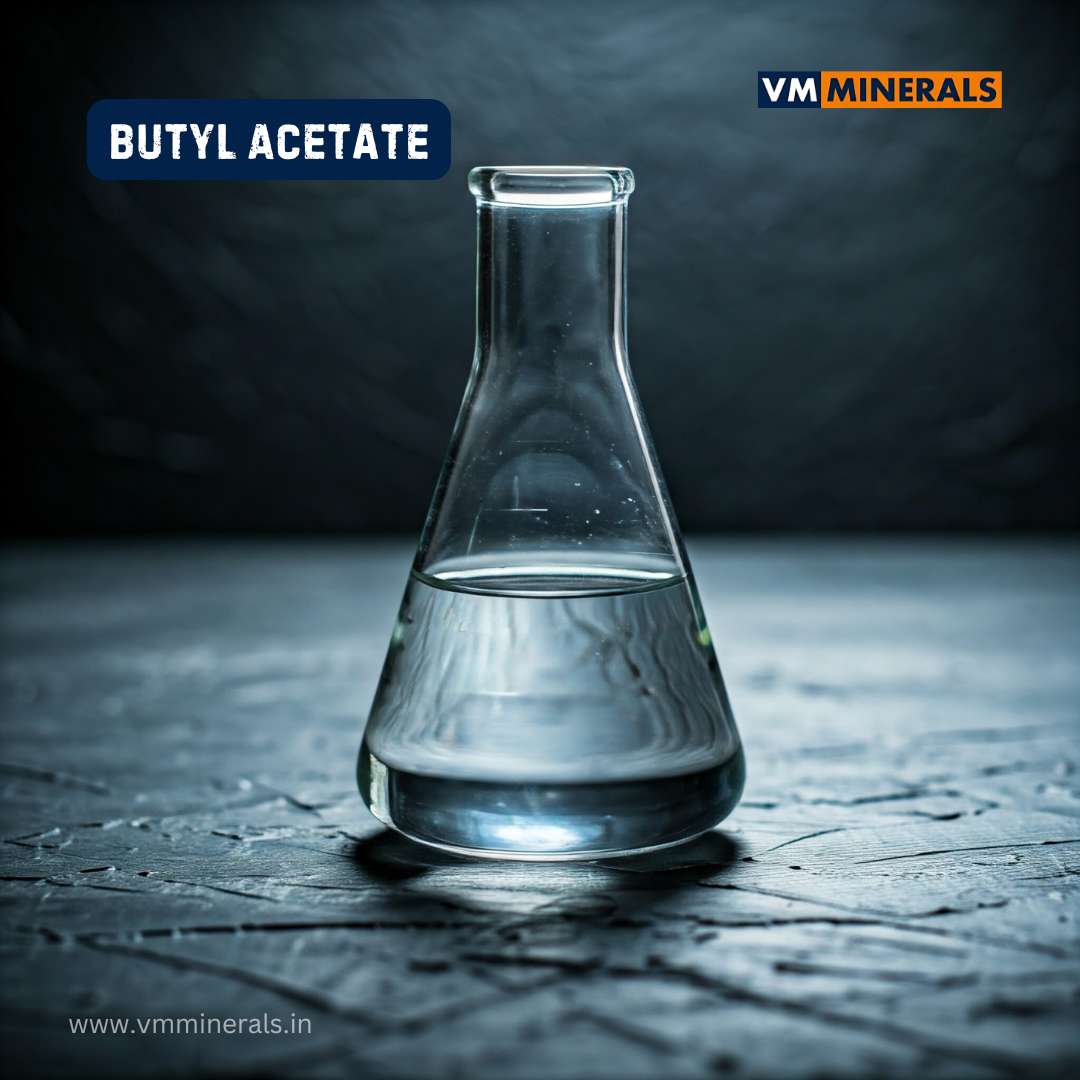Butyl Acetate by VM Minerals: Properties, Applications, and Safety
Introduction to Butyl Acetate
Butyl acetate, a versatile ester compound with the chemical formula C₆H₁₂O₂, is a colorless liquid known for its sweet, fruity odor. As a leading supplier of butyl acetate, VM Minerals ensures top-quality products for industrial, commercial, and specialty applications. Its wide range of uses in coatings, adhesives, and perfumes makes it a vital component in numerous sectors.
Butyl Acetate Formula and Structure
What is the Formula of Butyl Acetate?
The molecular formula of butyl acetate is C₆H₁₂O₂, which combines butanol and acetic acid through esterification.
Structural Representation of Butyl Acetate
Its structural formula can be represented as CH₃COO(CH₂)₃CH₃, featuring a carboxyl group (-COO-) linked to a butyl group (-CH₂CH₂CH₂CH₃).
Chemical Composition
Butyl acetate comprises two primary components:
- Butanol (C₄H₁₀O): A four-carbon alcohol.
- Acetic Acid (CH₃COOH): A two-carbon carboxylic acid.
Physical and Chemical Properties of Butyl Acetate
Boiling Point of Butyl Acetate
Butyl acetate has a boiling point of 126°C (258°F), making it an effective solvent for high-temperature applications.
Other Physical Properties
- Molecular Weight: 116.16 g/mol
- Density: 0.882 g/cm³ at 20°C
- Melting Point: -73°C (-99°F)
- Solubility: Slightly soluble in water but highly soluble in organic solvents.
Chemical Behavior and Reactivity
- Non-reactive under standard conditions.
Hydrolyzes in the presence of strong acids or bases, reverting to butanol and acetic acid.
Applications of Butyl Acetate
Butyl Acetate in Industrial Processes
As a high-performance solvent, butyl acetate is integral to manufacturing coatings, resins, and polymers.
Role in Paints, Coatings, and Adhesives
Butyl acetate is favored in these industries due to its:
- Efficient Drying Properties: Ensures a smooth finish.
- Compatibility: Works with a wide range of resins and pigments.
Use in Perfumes and Flavorings
Its pleasant fruity aroma makes butyl acetate a popular choice in:
- Perfume formulations as a fragrance carrier.
- Flavoring agents for food and beverages.
Why Choose VM Minerals for Butyl Acetate?
Commitment to Quality
VM Minerals ensures high-purity butyl acetate that meets international standards.
Competitive Pricing and Reliable Supply Chain
We offer cost-effective solutions with timely delivery to maintain your business operations seamlessly.
Customer Support and Customization
Our team provides tailored solutions to suit your specific industrial needs.
Safety Guidelines for Handling Butyl Acetate
Health Hazards of Butyl Acetate
- Prolonged exposure can lead to dizziness, headaches, and irritation of the respiratory tract.
- Direct skin or eye contact may cause mild irritation.
Proper Storage and Transportation Methods
- Store in a cool, well-ventilated area away from heat sources.
Use approved containers for safe transportation.
Environmental Impact of Butyl Acetate
Eco-Friendliness of Butyl Acetate
- Butyl acetate biodegrades under aerobic conditions, making it relatively eco-friendly.
- Environmental Regulations and Compliance
- VM Minerals ensures all products comply with global environmental standards, minimizing ecological impact.
Comparison with Other Solvents
Butyl Acetate vs. Ethyl Acetate
- Butyl Acetate: Higher boiling point; better suited for industrial coatings.
- Ethyl Acetate: Faster evaporation; commonly used in adhesives.
Butyl Acetate vs. Propyl Acetate
- Butyl Acetate: More stable and effective for long-lasting finishes.
- Propyl Acetate: Lower boiling point; used for specific fast-drying applications.
Reactions Involving Butyl Acetate
Hydrolysis of Butyl Acetate
In the presence of water and strong acid or base, butyl acetate breaks down into butanol and acetic acid.
Combustion of Butyl Acetate
When combusted, butyl acetate produces carbon dioxide and water.
Reaction:
C₆H₁₂O₂ + 8O₂ → 6CO₂ + 6H₂O
Frequently Asked Questions (FAQs)
What is Butyl Acetate Used For?
Butyl acetate is widely used in paints, coatings, adhesives, perfumes, and flavorings.
What is the Boiling Point of Butyl Acetate?
It has a boiling point of 126°C (258°F).
Is Butyl Acetate Eco-Friendly?
Yes, it biodegrades in the environment, making it a safer choice for industrial use.
How Should Butyl Acetate Be Stored?
Store it in cool, ventilated spaces away from ignition sources.
Why is Butyl Acetate Preferred in Paints and Coatings?
Its excellent drying properties and compatibility with resins make it ideal for smooth, durable finishes.
What is the Role of Butyl Acetate in Flavoring Agents?
Its fruity aroma enhances the flavor profile of food and beverages.
Specifications
| Parameter | Specification |
|---|---|
| Chemical Formula | C₆H₁₂O₂ |
| Molecular Weight | 116.16 g/mol |
| Purity | ≥ 99.0% (varies by grade) |
| Appearance | Clear, colorless liquid |
| Odor | Fruity, sweet, and pleasant |
| Boiling Point | 124-126°C |
| Density | 0.878-0.882 g/cm³ at 20°C |
| Melting Point | -78°C |
| Flash Point | 27°C (closed cup) |
| Refractive Index | 1.394-1.396 at 20°C |
| Solubility | Slightly soluble in water (5 g/L at 20°C); soluble in organic solvents like ethanol, ether, and acetone |
| Acidity (as Acetic Acid) | ≤ 0.005% |
| Moisture Content (Karl Fischer) | ≤ 0.05% |
| Residue on Evaporation | ≤ 0.01% |
| Color (APHA) | ≤ 10 (high-purity grade) |
Trade Information
| Minimum order | 200 LTRS |
| Supply ability | Upto 50 MT per day |
| Delivery time | 48 Hrs. from the date of payment receipt |
| Payment terms | Advance payment before loading |
| Supply area | Tamil Nadu, Andhra Pradesh, Kerala, Karnataka & Telangana |
| Sample policy | Free samples are available |

